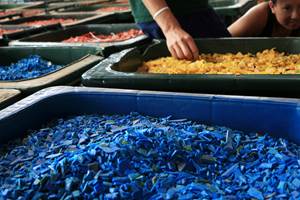Novel Flat Fiberglass Boasts Several Benefits for Thermoplastic Composites
Flat vs. round fiberglass allows higher fiber loading levels and better mechanical properties—including higher impact strength.
Over the years, we have seen a continued evolution in fiberglass reinforcements for thermoplastics ranging from hollow glass spheres and chopped strand glass for high-temperature engineering resins to long-glass-fibers to hybrid long glass/carbon fibers. A key aim is lightweighting as well as improving mechanical properties. Likewise, a key challenge is ease of processing. Recently, a unique family of fiberglass products with a flat rather than round cross-section was launched by Chongging Polycomp International Corp. (CPIC), Amsterdam (Albany), N.Y., which may address these key issues.
Headquartered in Dadukou, China, CPIC is a subsidiary of YTH Group—a global conglomerate of fiberglass, mineral, composites, textiles, financing, and trading companies, and is reportedly the world’s third-largest fiberglass manufacturer by installed volume. The new flat vs. round fiberglass is said to facilitate higher fiber loading levels and better mechanical properties—including higher impact strength, in injection-molded thermoplastic composites. This, while reducing warpage in thin-wall sections.
The flat glass reportedly enhances thermoplastic processing by lowering resin shear, providing better fluidity (increasing spiral flow), reducing friction and viscosity buildup, and lowering fiber entanglement and breakage since the flat fibers tend to flow in planar sheets like mica rather than rolling and rumbling like conventional round glass filaments. In turn, this is said to help provide for a more isotropic dispersion and also allows higher fiber-volume fractions (FCFs) to be achieved with no other changes because the fibers pack more closely as has been confirmed by scanning-electron micrograph (SEM) images.
Warpage (differential shrinkage and residual stress relaxation) of a plastic or composite part after demolding can be a serious problem because its changes final part dimensions and location of mating surfaces. Additionally, there is an adverse effect on aesthetics. Warpages tends to be a function of non-uniform shrinkage between flow and cross-flow directions of a part, which is particularly exacerbated in high-pressure processes like injection molding. This, because more fibers line up in the direction that polymer flows into the tool rather than in the cross-flow direction. In turn, this leads to higher shrinkage and therefore warpage in the cross-flow direction.
In the case of thin-wall parts, the cross-flow (through-thickness) direction represents a larger ratio vs. skins aligned with resin flow, so the effects of the non-uniform shrinkage are more pronounced. To an extent, design and gate placements can help reduce warpage as can process changes such as lowering speeds of fill and/or packing pressures.
However, CPIC’s new flat glass helps reduce warpage significantly without any other changes simply by virtue of how the reinforcement fills parts and how it behaves in conjunction with the resin matrix. Moreover, its helps reduce molding pressures and enables the same part to be molded on smaller injection presses with fewer gates. Glass-filled crystalline parts using this flat fiber are molded as thin a 1 mm/0.04 in. without warpage. The flat fibers are said to exhibit excellent bonding and mechanical properties and are viewed as ideal for application in the automotive as well as electrical/electronic industries. In all other properties, the flat strands are said to be equivalent to conventional round glass fiber of the same type at the same loading.
Initially, the new flat fiberglass reinforcements are being offered in E-glass (ECT) form with filament widths of 28 µm (microns) vs. conventional round glass where filaments for chopped strands typically range from 10-13 µm in diameter. The flat strands are subsequently chopped to either 3.0mm/0.12 in. (the most common lengths for short-glass injection grades in Europe) or 4.5mm/0.18 in. (the most common length for short-glass injection grades in North America), or it is milled.
Three grades of fiber are offered in both the 1:3 and 1:4 length/width ratios as well as milled forms. The fibers feature unique surface-treatment (sizing) technology for use in nylon, PPA, PBT, PPS, and PC resins. Each product may be purchased in either 25-kg/55-lb paper bags or 1000-kg/2205-lb. supersacks.
Fiber shape (flat, round) is only one aspect of glass properties that CPIC can manipulate to create products that meet unique client needs. Other properties that can be modified include the type of sizing used, the type of glass used, and additional special functionality that can be added (e.g., flame retardance, antistatic properties).
Related Content
Intrinsic Viscosity Enhancer for rPET and PET Food-Contact Applications
Nexam’s Nexamite MO2100 rebuilds molecular weight and increases IV to enable upcycling of rPET.
Read MoreICIS Launches: Ask ICIS Generative AI Commodities Assistant
Said to be the first of its kind, this AI assistant will enhance access to ICIS’ intelligence and insights for the energy and chemical markets.
Read MoreAt NPE2024, Follow These Megatrends in Materials and Additives
Offerings range from recycled, biobased, biodegradable and monomaterial structures that enhance recyclability to additives that are more efficient, sustainable and safer to use.
Read MoreCompatibilizer for Nylon/ABS Alloys
CAI Performance Additives’ ST-AN3230 has shown to improve both compatibility and performance of nylon/ABS alloys.
Read MoreRead Next
Beyond Prototypes: 8 Ways the Plastics Industry Is Using 3D Printing
Plastics processors are finding applications for 3D printing around the plant and across the supply chain. Here are 8 examples to look for at NPE2024.
Read MoreSee Recyclers Close the Loop on Trade Show Production Scrap at NPE2024
A collaboration between show organizer PLASTICS, recycler CPR and size reduction experts WEIMA and Conair recovered and recycled all production scrap at NPE2024.
Read MoreMaking the Circular Economy a Reality
Driven by brand owner demands and new worldwide legislation, the entire supply chain is working toward the shift to circularity, with some evidence the circular economy has already begun.
Read More


























